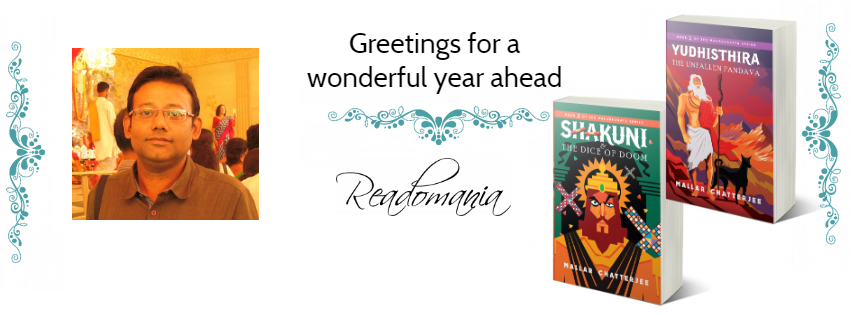Before the start of the Kurukshetra war, Vyasa asked the blind Dhritarashtra whether he wanted to watch the war through a divine vision. Dhritarashtra, although interested to be kept posted to the developments in real-time, was reluctant to see the horrible manslaughter with his own eyes. Vyasa then appointed Sanjaya to give a running commentary of the battle to Dhritarashtra. Sanjaya was extremely meritorious and a close confidante of the blind king. Vyasa granted a special vision to Sanjaya that enabled him to see everything afar.
The impending doom made Dhritarashtra philosophical. He asked Sanjaya why almost all major battles are fought over pieces of land which are nothing but small portions of the earth. He wanted to know the real worth of earth and also became curious about its topography. Responding to Dhritarashtra’s queries, Sanjaya revealed to him what was then the contemporary idea of the world’s geography.
According to the Mahabharata (told through Sanjaya), there was a circular or wheel-shaped island called Sudarshana Dwipa. Due to the abundant presence of blackberry trees on that island, it was more famously known as Jambu Dwipa. Jambu Dwipa was surrounded on all four sides by salty oceans – generally called as Lavana Sagara. There were six great mountain ranges that lay laterally across the island. The mountains were Himavat, Hemakuta, Nishadha, Nila, Shveta and Shringavan, all separated from each other by vast expanses lying in between them. The space between the two mountains was called Varsha. The Varshas were filled with beautiful kingdoms, forests, rivers, etc.
Our kingdom Bharata Varsha – named after the eponymous king – was located to the south of the Himavat mountain (the Himalayas – as we call it today). To the north of Himavat was located Haimavat Varsha (probably Central Asia or Pamir plateau) which was bordered by the Hemakuta mountain (probably Mount Kailash) on the northern side. Beyond Hemakuta was the region called Hari Varsha. To the north of Hari Varsha, there were mountains called Nishadha (Altai mountains of Central Asia?), Malyavat, Meru (Northern Pamirs?), Gandhamadana (different from the hill of the same name mentioned in the Ramayana), Nila, Shveta and Shringavan – one after another from the south to the north. Of these mountains, Meru Parvat was given special reverential importance in Hindu, Buddhist, and Jain mythologies, often being described as a golden mountain closely associated with gods. Besides the aforementioned three Varshas (Bharata, Haimavat and Hari Varsha), there were four more Varshas. Sequentially northwards, these bow-shaped Varshas were called Ilavrita, Shveta, Hiranyaka and Airavata Varshas. The northernmost region, i.e the Airavata Varsha probably corresponds to upper Siberia – which was often loosely mentioned in the Mahabharata as Uttarakuru. The Ilavrita Varsha was widely believed as the midriff of the Jambu Dwipa.
According to the Puranas, there were seven islands (Dwipa) on this planet, including the Jambu Dwipa, floating on as many oceans. The other six Dwipas were Plaksha, Shaka, Kusha, Krauncha, Shalmali, and Pushkara. If we compare this concept with our knowledge of the earth, it can be understood that these islands are nothing but what we call continents today – exactly seven in number! Jambu Dwipa is clearly a part of Asia – probably Central and Eastern Asia. Plaksha Dwipa is possibly South America, Shaka Europe, Kusha Australia or Oceania, Krauncha Africa, Shalmali Antarctica, and Pushkara North America. The Puranas also mentioned about the existence of Sapta Sindhu – seven great seas. These seas (Sindhu or Sagara) were called Lavana (meaning salt), Ikshu (sugarcane), Dadhi (curd), Dugdha (milk), Jala (water), Sura (wine) and Sarpa (serpent) possibly corresponding to the seven oceans of today.
It is quite amazing that our proto-historic ancestors could achieve a fairly correct idea about the globe, albeit with a few factual inaccuracies that they tried to cover up creating a haze of mysticism. Nonetheless, their achievement was still astounding considering the fact that it was well-nigh impossible for them to travel or navigate across the world at that time. Then how were they able to know or at least imagine this much? Close interaction with other contemporary cultures might have enlightened our ancient forefathers. Besides, the migratory Aryans used to travel all the time and they thus managed to gather deep knowledge over a vast region. Their knowledge added up to that of their non-Aryan predecessors who had already become geographically conscious through trade or diplomatic relations with other civilisations that were simultaneously thriving at other parts of the world.
The Mahabharata depicted that a blind man (Dhritarashtra), of all persons, received this knowledge (through Sanjaya). Isn't it quite intriguing? A man who had no vision at all got endowed with this precious world vision that very few of his time were privy to! Even Sanjaya needed a divine farsight (granted by Vyasa) to learn this and watch the proceedings of the battle to relay to Dhritarashtra. Perhaps this was a kind of symbolism to convey a message that this very special knowledge the ancient rishis and ascetics acquired actually came more from inner wisdom rather than direct experiences. If it was so, that inner wisdom might have stemmed from the synthetic culture comprising both the Aryan and the non-Aryan cognitions and beliefs that enriched our country since the antiquity of the Bronze age.
The modern idea of the world geography owes much to the efforts of the European powers for colonial expansion around the fifteenth century which is often mentioned in history as the “Age of Discovery”. Does not the term “Discovery” sound insulting? It was but their ignorance that they had not earlier been aware of those rich civilisations that they would later convert into colonies and exploit to the hilt, even destroy. And, our ancient texts indicate that the existence of even far-flung continents was known to us since antiquity, albeit without many factual details. In a way, we had “discovered” them long before they actually became aware of us.
______________________________________________________________________________________________________
Read Mallar Chatterjee's #MahabharatSeries, Yudhisthira & Shakuni to explore a distinct and different perspective of the epic. It is now available online and in all major bookstores.


Comments